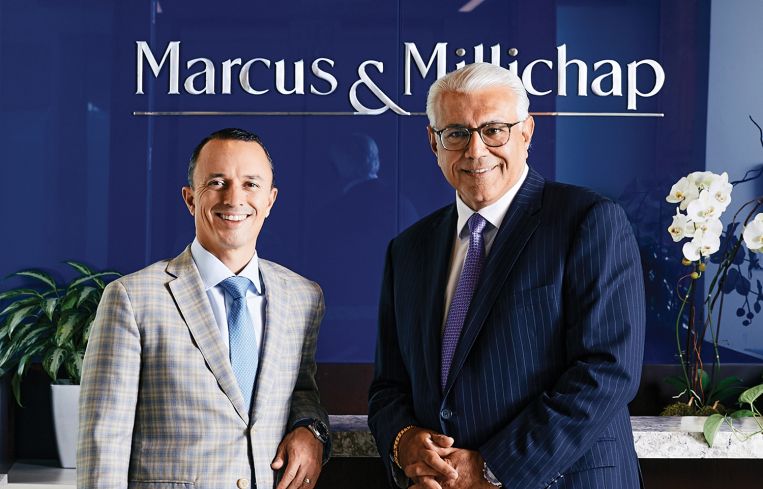Marcus & Millichap On the Science and Art of Tech and AI in Commercial Real Estate
Hessam Nadji and Richard Matricaria discuss the new era of machine learning and advanced technologies, all to enhance the same goals and policies as 50 years ago
By Greg Cornfield July 16, 2024 9:55 am
reprints
The commercial real estate industry has been notoriously slow in adapting to new technologies. Not so for Marcus & Millichap.
The brokerage services firm had an electronic inventory system dating back to the 1970s, which evolved and went live online in the 1990s as one of the first internet-based commercial real estate inventory outlets. Marcus & Millichap was also an early investor in major proptech advancements, particularly with its M&M Venture Partners, which launched over 20 years ago to tap into new startups. It backed firms like Spring Street, which later became Apartments.com, and was an initial investor in commercial real estate listings site LoopNet too.
However, two words put those efforts into the deep recesses of the rearview mirror today: artificial intelligence. And Marcus & Millichap is again trying to be a pioneer by embracing and utilizing AI every day.
Last year, Marcus & Millichap announced a new partnership with Archer, an artificial intelligence-propelled tool that quickly aggregates property financials and other data to make deal sourcing and underwriting more efficient. A few weeks later, the Calabasas, Calif.-based brokerage announced plans to partner with EquityMultiple, a crowdfunding platform.
Commercial Observer sat down last week with Hessam Nadji, president and CEO of Marcus & Millichap, and Richard Matricaria, chief operating officer of the firm’s Western Division, to discuss the ways the firm continues to lead the industry into a new era by utilizing advanced technologies, all while maintaining the same goals and policies that the brokerage was founded on more than 50 years ago.
This interview has been edited for length and clarity.
Commercial Observer: What’s the biggest or most game-changing way you’ve seen AI or proptech infiltrate commercial real estate?
Richard Matricaria: It has a lot of different use cases.
The way we’ve thought about it is: How can we use it to fast-track our own sales force in terms of their underwriting of properties, which is all the work that we do to value a property. So AI and machine learning is prevalent in what they call automated valuation models, which is exactly what Archer is. You can type an address in, and they will use different data sources to arrive at a predictive underwriting of a property at a valuation and put pricing on that’s highly accurate.
It saves a ton of time where, historically, analysts’ role was kind of chopped up into data input and then doing the analysis. This allows them to be more of an analyst, actually understanding the numbers and double clicking on what they mean, and drawing conclusions, and ascertaining what the value really is. It’s taken a lot of the input out of it, but then it’s also given some insights relative to the market, too.

That’s one big use case for us, and I think it’s across the industry. I think owners are using AI. I think the industry in general is probably figuring out how to use it. It’s at a pretty embryonic stage, and everybody’s figuring out what works for them based on their own use of technology and the current state, prior to integrating any AI.
Hessam Nadji: I view it as several phases. In the current phase, Richard articulated the application to the underwriting and really the preparation of market intelligence before a broker can go meet with a client or convey their expertise, which is the most relevant, because that’s what we do every single day.
The additional applications of it also have to do with the way market overviews are written — whether it’s in proposals or marketing packages, or some of our research content. AI is helping to make the writing process more efficient. The machine learning component of our proprietary internal tools, as Richard described in matching buyers and sellers, is another very important piece to bring that efficiency to our agents.
If you boil it all down, it’s about making the individual broker as efficient as possible and as well-informed as possible.
RM: Another piece that we’re utilizing with our investment in Archer, and just internally in general, is predicting who the sellers are going to be. That means predicting who might have a capital event need coming up because a balloon payment is coming due — which brokers love. So it streamlines who they reach out to in a more probable way on the brokerage side.
I think our clients are using it, and are getting more and more sophisticated on the other bucket of research. Clients are using it for demand forecasting. They’ve become so sophisticated. I can think of several clients who have built their own models where they’re taking factors like GDP and population growth and job growth and figuring out net migration statistics, and they’re trying to model out where rents are going, where occupancies are going, to ascertain where values are going to increase.
And we’re trying to get ahead of that, too, on their behalf through our research department. It’s a very valuable thing: If you can figure out where rents are going and where they’re underpriced today, you can really buy into a lot of value.
How has it been seeing the adaption and then adoption of newer technologies throughout the years?
HN: With the last 24 months and the buzz around AI, now it seems like an ice cream vendor around the street corner is trying to use AI to sell more ice cream.
When you talk about AI-enabled brokerages, for me, it’s interesting to watch that perspective and the buzz around it.
I was a computer science major and got my bachelor’s degree in programming and systems analysis and data management so many evolutions ago. That goes back to the mid-`80s, when I started my career at Grubb & Ellis, and grew to head up their research and technology. Ten years later, I was recruited by Bill Millichap and George Marcus and learned about the company, and it ended up changing my career. A lot of the conversation was around technology, because Marcus & Millichap was the first company that I know of that had an electronic listing inventory system as early as the late `70s.
The notion of the company’s business model is all about exposing a piece of real estate to the largest pool of qualified buyers. That’s what we started doing in 1971, that’s what we’re doing today.
We bring efficiency to that process and make a market for each asset. And this started out first and foremost by taking that first notion to then a policy of requiring information sharing within the company, where individual brokers didn’t hide their listing from their colleague down the hall. There has been a mandatory culture of information sharing dating back to the founding of the firm.
The more information is shared, the more brokers can expose each property to their potential buyers, all of which started out as a manual process with what we used to call “the inventory board” sitting outside of a regional manager’s office. Everybody would walk by every Monday to see what was new and what had been sold from last week.
That generated the need to create an electronic inventory system called the Ginny in 1977 for Marcus & Millichap. The company, at the time, only had a handful of offices. But they created a connectivity among those offices with a centralized inventory system.
That technology has been in our DNA because the policy that founded this entire business model was about internal information sharing and exposing each property to the largest pool of the most qualified buyers for that property. And it’s evolved 1,000-fold since then.
Fast forward to 1994, Bill Millichap also pioneered us to being the first commercial real estate firm that had basically an internet-based inventory outlet on our website, one of the first websites to be introduced within commercial real estate, and it also included our inventory.
So, the notion of pioneering ways to use technology for our business model goes back to our founding. And, several generations later, we still find ourselves constantly looking for ways to do the same thing: Expose a piece of real estate to the largest pool of the most qualified buyers better and better.

RM: This area of proptech is so vast. To Hessam’s point, AI is used and thrown around a lot as a buzzword. And I think the industry at large — clients, brokerage firms, everybody alike — is trying to figure out different use cases.
A lot of what we’re doing as an organization is figuring out, in this vast proptech world that has come to be, which pieces of it should we build or own for ourselves in a proprietary manner, versus which ones do we adopt and integrate into our system through different API connections, where it’s more economical for us.
I’m on the Urban Land Institute’s technology council. The industry has been historically slower to adopt technology. I think we’re faster than the industry by a long shot, but it’s fascinating because there are large building owners now trying to use machine learning and data to become more energy efficient with their building. That bleeds into decarbonization of buildings and lowering operating costs.
Is there an idea of one day there being a Marcus & Millichap platform using AI and the firm’s exclusive data for clients or the public? Or is it just for brokers to be the best for the clients?
HN: There’s a big difference between publicly available data and proprietary internal data. Same thing with applications.
Let me go back a little bit to how we view the integration of AI into our system. Our current organizational structure has a lot to do with how we integrate technology or develop technology. We have two chief operating officers: Richard covering the Western U.S., and his counterpart, J.D. Parker, based in New York overseeing the Eastern U.S.
We also have a chief administrative officer, Greg LaBerge, who oversees infrastructure for the firm and a variety of different aspects and operations, and a chief information officer who is essentially responsible for everything “technology” — whether it’s infrastructure, security, application development and so on.
All of these executives are constantly thinking not just about the traditional aspects of the business, but how technology improves the daily operations. All of the investments we’ve made, partnerships we’ve made on proprietary projects we’ve developed in-house, have been initiated either by Richard, J.D., Greg, or someone on the team that reports to them, as business sponsors.
The way we’re set up, they’re basically tasked as business representatives of what our clients need and what our brokers need. And we sit around the table as a C-suite and prioritize which projects are going to be worked on and get capital behind them.
So Richard was the executive who discovered and brought Archer to the table, and sponsored it within our own core team as to why the company should get behind this concept and become an investor in it. His counterpart, J.D. Parker, did the same with EquityMultiple.
We put a lot of premium value on our own internal data, and we’re making as much progress in better utilizing internal data to create certain indices, to supplement the external data and AI and automation coming from Archer or EquityMultiple or other partners.
Can we expect more of these tech-based investments or partnerships from Marcus & Millichap in the near future?
HN: I would sure hope to see an ongoing flow of some of those innovations for similar partnerships.
The one overarching thing about all this is that I don’t anticipate we’ll get to a point where the financial analysis and the market analysis necessary for one of our brokers to go meet with a client to talk about their investment is all dumped by machines, and they just grab it off the printer. If that were to happen, I think the client will be at a disservice because at the end of the day, the broker can be more efficient in reviewing the information, and drawing conclusions based on key metrics, such as estimated net operating income or suggested value range.
However advanced AI gets, we will never replace the street knowledge of the broker, the training that the broker gets in relationship management, and being able to add value for the client as an adviser, no matter what the data says or how accurate it is because of AI or how much faster it comes out of the machine.
Those advisory functions are so unique by client and by asset that the idea that you can say, “Siri, what’s my property worth? Should I sell it now or refi?” — would be at a disservice to the investor.
The unique part of our business in commercial real estate is that no two assets are the same. You can have two properties identically built across the street from each other, and open for business the same day. Ten years later, those two properties most likely will be entirely different investment prospects because of the way they were managed, maintained, the tenant profile, and the attitude and needs of the owners.
There are passive owners that have rents that are way under market, and a good broker would advise that client not to leave value on the table. I’m not so sure AI would.
RM: There’s always a human element to it, and there’s always a story behind each owner’s strategy and each piece of real estate. The analytics can help you get to a certain point quicker, but then the human element allows you to go to the next full step, to really advise the client in the best way per their strategy.
It goes back to a core principle, which is building and maintaining relationships with people. It’s a people business.
HN: That’s on the front end of how you interact with a client. On the back end, of actually taking a piece of real estate to market, I cannot tell you how much less science there is and how much more art there is to generate those multiple offers. It’s knowing which buyers are most likely to perform because you have that intuition or knowledge about the buyers’ history, and you know where they’re getting their financing, knowing if your seller has a family emergency or other financial needs where a quick sale at a good price is more important than a slow sale at a great price. It all depends on those unique circumstances for the client.
Then there’s a whole third phase of saying, “Alright, now I generated all these buyers. Great job, AI. Thank you, that was so fast and efficient.” From there on, the art has to take over of really executing a transaction.
There is a standing fear that the growth of AI could lead to the demise of analysts or brokers. What do you think of that?
HN: I think we’ll probably need fewer analysts, just from a body count perspective, in time. But the analysts you will have will be more senior analysts, and they will have more time to really analyze instead of data input. So it will change the nature of even our analyst pool.
RM: I don’t believe bots are going to be selling commercial properties, or solving title issues and environmental issues and all the different things that come up in a transaction. I don’t see machine learning solving for that. Those are human beings negotiating and having relationships with each other and entrusting each other to work through issues on complex transactions. All of the data and analytics and proptech that we’re leveraging help us get to better insights and navigate those conversations.
Are there any other new forms of tech, or other ways you think the industry is going to be dramatically affected? Or any other advancements that differentiate Marcus & Millichap?
HN: Our “My MMI” application and “save search” is a great evolution that started in the early 2000s where we had a system called Buyers’ Needs.
Initially, it was agents looking for a buyer. As an example, they would say they’re looking for apartment investment of a certain price range, a certain cap rate, and the certain markets they’re interested in. And the system would just constantly search, and, if you had a match, they would inform the agent representing the buyer.
It was a very rudimentary way to try and harness our active inventory, which changes all the time. But that has now gone into several rounds of evolution and automation over time.
RM: Now, there’s a whole top-of-funnel strategy right down to who becomes a client. They’re signing up with their acquisition criteria, they’re letting us know where they are in their buying process. And it becomes very powerful to make a market for clients.
HN: A potential investor gets a feed based on their behavior on our website or what they registered for.
RM: There’re a lot of possibilities. It’s exciting to think about.
HN: It can also be distracting.
Is that a concern?
HN: As a management team, we have to make sure we don’t get splintered into different directions. We have to pick our priorities, and invest the right capital, and focus.
Gregory Cornfield can be reached at gcornfield@commercialobserver.com.


